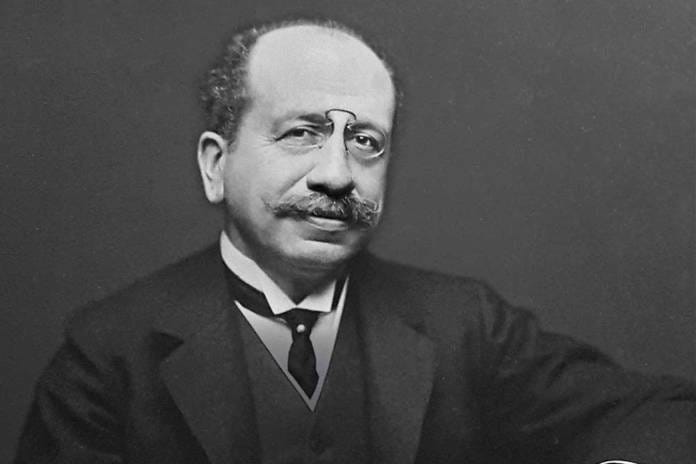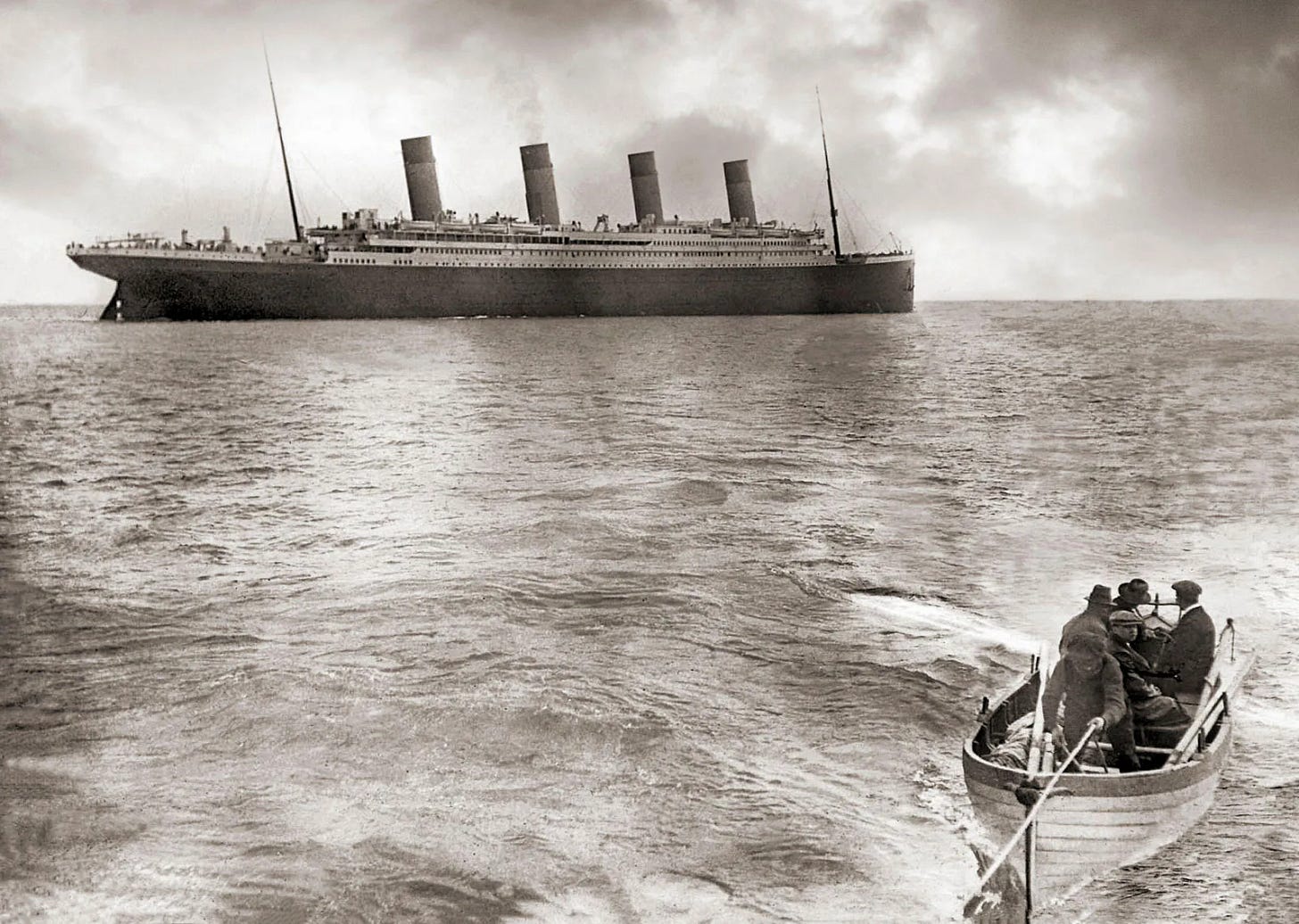Steel, Profit, and Cost-Cutting
A little-known letter by a German Jewish shipping magnate offers insight into why the "Titanic" sank so quickly
Albert Ballin (1857-1918), general director of the Hamburg-America Line. A German Jew, Ballin transformed HAPAG into the largest shipping company in the world, and the biggest carrier of Eastern European immigrants to America.
Early on the morning of April 15, 1912, the grim headline went up: in The New York Times: “New Liner Titanic Hits an Iceberg, Sinking…Last Wireless at 12:27 A.M. Blurred”.
Ever since, the Titanic disaster has maintained its grip on our minds and emotions. But on one fundamental fact, the popular image is wrong. It was not just a giant iceberg that caused the largest ship in the world to disappear beneath the frigid waters of the North Atlantic. A critical culprit was major cost-cutting by her builders and owner, the White Star Line, to save on fuel and construction expenses. The North Atlantic was at the beginning of the 20th century the arena of intense Anglo-German rivalry among competing shipping lines. And the Titanic was meant to take the lead in that competition.
In researching in a German archive for my new book The Last Ships from Hamburg, I discovered a letter written by Albert Ballin, the head of White Star’s leading competitor that accurately intuited what went wrong. But it would take three quarters of a century before undersea exploration would prove Ballin right.
Until then the dreadful events were blamed on the iceberg. The world needed an explanation for what had happened: RMS Titanic, the largest and supposedly the safest ship in the world, was gone. 1,523 out of the 2,228 people onboard were presumed dead. She had hit an iceberg while traveling at full speed on a clear, moonless night. She went down in a mere two-and-a-half hours. Contrary to the captain’s order of women and children first, more first-class men (57 out of 118) survived the disaster than third-class children (27 out of 59).
For days, the world reeled in shock. The press speculated that it must have taken a terrific amount of damage to sink the Titanic. The most obvious reason for the tremendous loss of life, most people had pointed out, was that the ship had too few lifeboats. But there was also some speculation that the ship had structural problems. For how did the giant liner go down before help could arrive? The official British inquiry in 1912 dismissed the structural argument, concluding instead that it was the massive iceberg alone that sent the ship to the bottom of the ocean.
In Hamburg, Germany, Albert Ballin, the general director of the Hamburg-America Line (also known as HAPAG) had his own explanation for the disaster, built on experience. The Hamburg-America Line, White Star’s long-time rival and most formidable competitor, made most of its profits from the immigrant trade. This gained Ballin, a self-made German Jew, the moniker “The King of Steerage.” Thanks to his integrated rail-and-sea transportation network from the Russian-German border to New York, HAPAG’s immigration was an organized business rather than a chaotic free-for-all.
On April 20, eight days after the disaster and two days after the liner Carpathia landed Titanic’s 712 survivors in New York, Ballin wrote his good friend, the Hamburg-based banker Max Warburg, about why he thought Titanic went down. It was in the Warburg archives that I found that telling letter. In writing it, Ballin drew on his own experience.
“According to telegraphic reports from New York up to now, the Titanic disaster has only become more baffling to me,” Ballin wrote. “In light of the reports, which are only preliminary, after all, I can’t help but think that the material [i.e. of the ship] was too soft and that its construction was too lightweight.”
While the press pilloried the White Star Line for failing to provide adequate lifeboats, Ballin had a very different perspective on the catastrophe. No ship on the Atlantic carried enough lifeboats for all onboard, including those flying the HAPAG ensign. Ballin believed that the real cause was White Star’s quest to save money on construction and fuel consumption and the ship builders complicity in those objectives.
The RMS Titanic departing Queenstown, Ireland on April 11, 1912. Taken from a tender by Father Francis Browne, this is the last surviving image of the doomed liner. Five days after the disaster, Albert Ballin speculated that the ship sank in large part due to her construction being “too lightweight.”
Ballin had long used Harland & Wolff, the Belfast shipyard that had built Titanic, to construct ships for his own fleet. Among them was the SS Amerika of 1905, one of the largest liners flying the HAPAG flag. In addition to its luxurious first-class quarters (which included an extra-tariff Ritz-Carlton restaurant), Amerika could carry up to 2,500 immigrants in third class and steerage. This was in contrast to the newer and much larger Titanic, which could carry only 1,000 in third class.
As much as he liked Harland & Wolff’s designs, Ballin had sharp differences with the firm and remained unsatisfied with its original specifications for Amerika. After reviewing the plans, Ballin insisted that Amerika be constructed of thicker and higher-grade plating, and that the ship’s safety systems go above and beyond what Lord Pirrie, head of Harland & Wolff, produced for White Star.
Pirrie balked, but Ballin held firm on principle. “Lord Pirrie was always proud that he was able to build the White Star ships solely according to his own ideas,” Ballin wrote, “without regard for the regulations of the Classification Societies.”
“The ships that Harland’s built for us were therefore so disproportionately more expensive than the ones they built for the White Star Line,” he said, “because we had strict specifications from German Lloyd and the Maritime Employer’s Liability Insurance Association, and our own company.”
Passenger safety came first for him, and he felt that stronger construction, superior safety standards, and somewhat diminished fuel efficiency would pay off in the long run for Hamburg-America. Had Titanic been built to the standards he insisted upon, Ballin reasoned, she might have stayed afloat long enough for rescue vessels to arrive on the scene. Or she might not have gone down at all. “For years Lord Pirrie kept pointing out to me how much useless ballast we lug around with us due to material that is too strong and complicated safety precautions,” he concluded to Warburg. “Today, I fear, he will have a completely different opinion.”
The British inquiry into the Titanic disaster suppressed the testimony of witnesses who claimed to see the ship break apart. A vessel that the British press had called “practically unsinkable” could not have been torn apart in such a manner, let alone sink so fast. It must have been a 300-foot-long gash that doomed the liner.
It would take 73 years to prove Ballin’s intuition right. In 1985, explorer Robert Ballard found the wreckage of the Titanic on the bottom of the North Atlantic. It indeed had broken apart as it sank.
Further confirmation came thirteen years later, when Tim Foecke, a U.S. government metallurgist, performed an analysis of rivets salvaged from the sea floor. According to his findings, the Titanic’s wrought iron rivets contained three times the amount of slag (waste matter from smelting) permitted today, making these crucial structural elements susceptible to cracking, especially in icy water. The impact of the iceberg caused hundreds of the brittle rivet heads to sheer off, opening up seams between the steel plates and allowing water to flood into the ship.
After looking at a side scan sonar of the wreck’s starboard side, Foecke was astonished to discover that the three-football field long Titanic was sunk not by a long gash as concluded by the British wreck inquiry in 1912 and generally assumed ever since, but a series of small slits totaling only about 12 square feet. Or about the surface area of an average sized person.
Only days after the Titanic sank, Albert Ballin had correctly guessed the true cause of the Titanic catastrophe. The disaster would provide a grim and lasting lesson of what the costs can be when, in the rush for success, competitive ambitions and over-confidence take precedence over prudent judgment.
As for the sturdy Amerika, launched in 1905 with Ballin’s greater emphasis on safety in contrast to the Titanic, it remained in service for half a century, serving ironically during two world wars as an American troop transport and sailing the seas until the mid-1950s.
Steven Ujifusa is the author of The Last Ships from Hamburg: Business, Rivalry, and the Race to Save Russia’s Jews on the Eve of World War I (Harper Books, 2023). Follow him on X at stevenujifusa or visit his website www.stevenujifusa.com.





